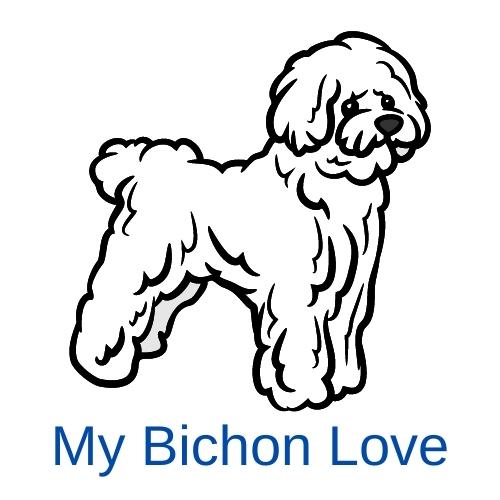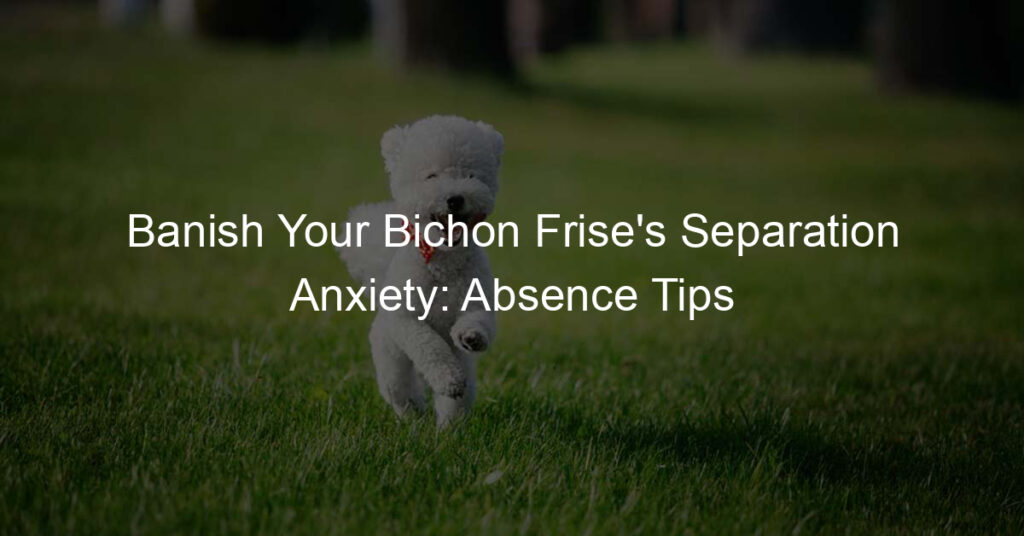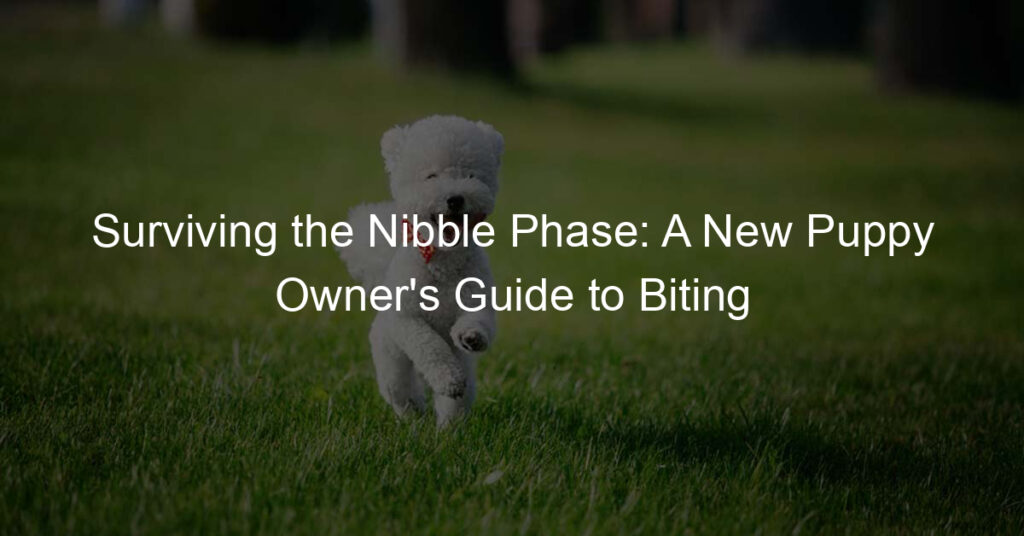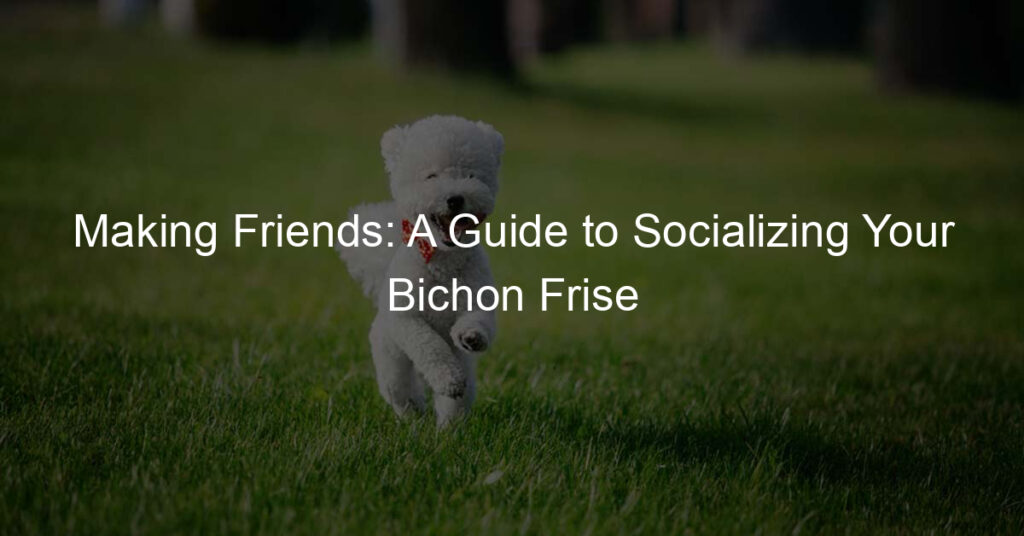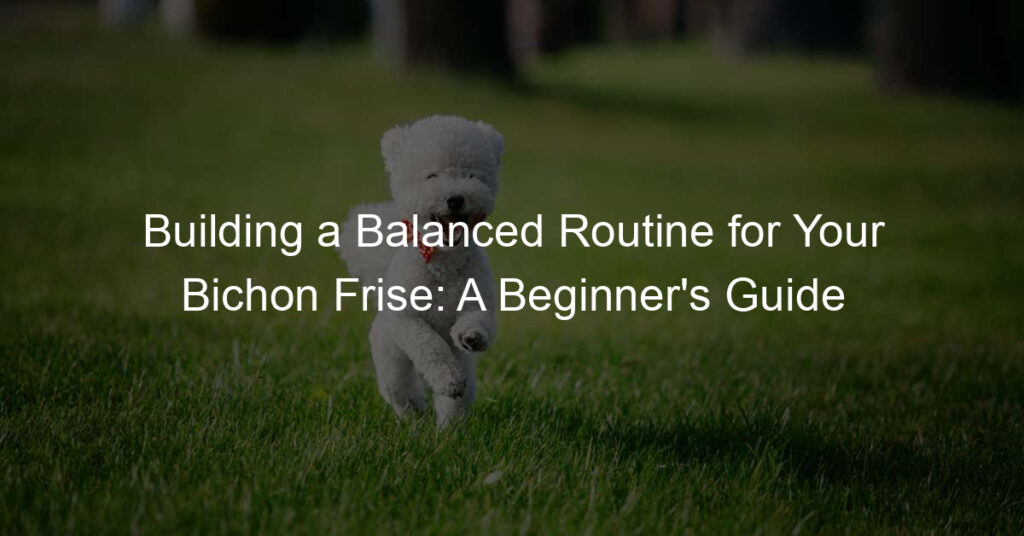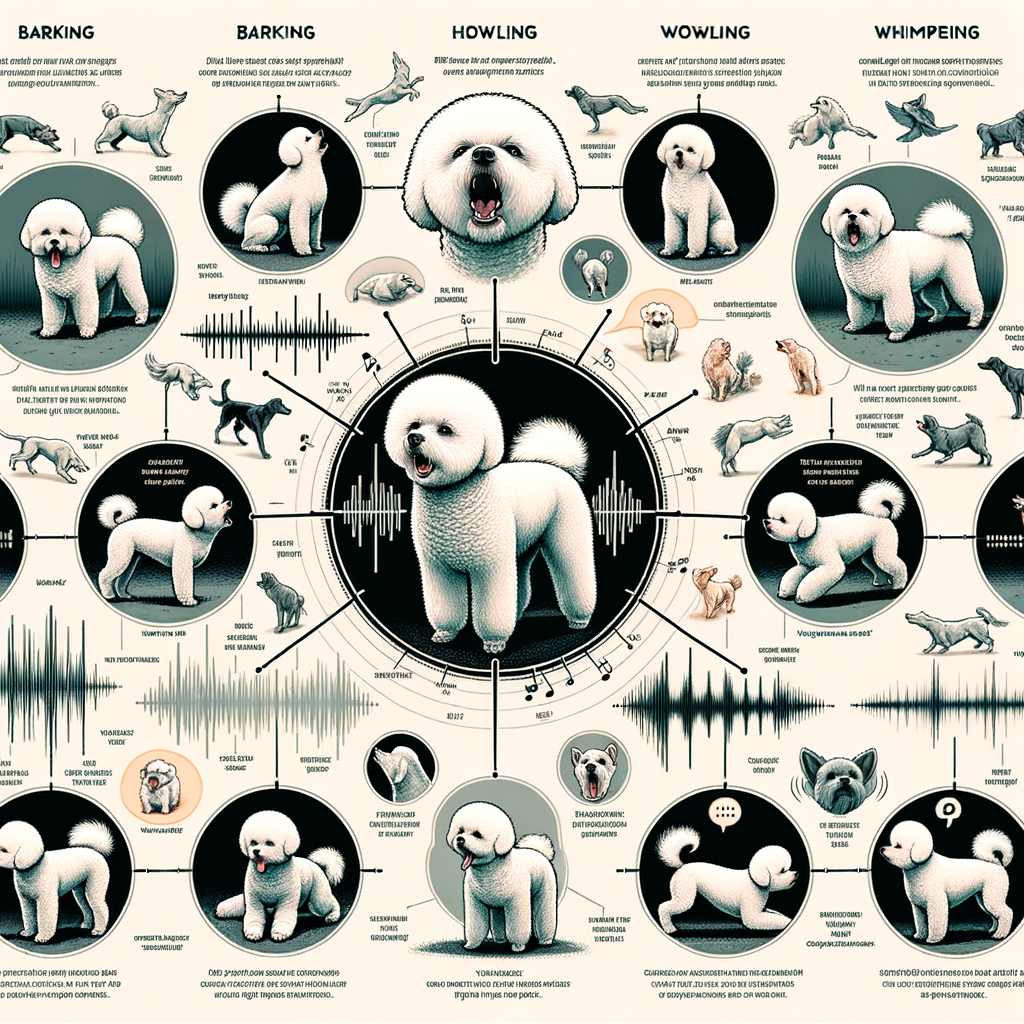
The Bichon Frise, a small, cheerful, and friendly breed, is known for its unique vocalizations. These sounds are more than just barks; they are a form of communication that allows these dogs to express their feelings, needs, and desires. Understanding these vocalizations is crucial for any Bichon Frise owner as it can significantly improve the bond between you and your furry friend.
Every sound that a Bichon Frise makes has a purpose. They may bark when they’re excited, whine when they’re anxious, or growl when they’re upset. By paying attention to these sounds and the circumstances in which they occur, you can learn to understand what your Bichon Frise is trying to communicate. This understanding can help you meet your pet’s needs more effectively, leading to a happier and healthier dog.
Bichon Frises communicate in a variety of ways. Vocalizations are just one part of their communication repertoire. They also use body language, facial expressions, and even scent to convey messages. However, vocalizations are often the most noticeable form of communication, especially for humans. Bichon Frises have a wide range of sounds, including barks, whines, growls, and even howls. Each of these sounds can mean something different depending on the context in which it is used.
In the following sections, we will delve deeper into the specific sounds that Bichon Frises make, what they mean, and how you can respond to them. By the end of this article, you will have a better understanding of your Bichon Frise’s unique voice and how to communicate with them more effectively.
Decoding Bichon Frise Barking
Understanding the barking of a Bichon Frise is an essential part of being a responsible pet owner. This breed is known for its lively and expressive nature, and their barks can tell you a lot about what they’re feeling or trying to communicate. Let’s delve into the different types of Bichon Frise barking and how to interpret them.
-
- Understanding the different types of Bichon Frise barking
Bichon Frises have a variety of barks, each with its own meaning. Here are the most common types:
-
-
- Alert Bark: This is a sharp, loud bark that your Bichon Frise will use when they notice something unusual. It’s their way of saying, “Hey, something’s not right here!”
- Playful Bark: This bark is usually higher-pitched and comes in a series of quick, excited yelps. It’s a clear sign that your Bichon Frise is in a playful mood and ready for some fun.
- Lonely Bark: If your Bichon Frise is left alone for too long, they might let out a long, mournful bark. This is their way of expressing loneliness and a desire for company.
- Frustrated Bark: A low, grumbling bark usually indicates frustration. Your Bichon Frise might use this bark when they can’t reach a toy or when they’re not getting what they want.
- How to interpret Bichon Frise barking
-
Interpreting your Bichon Frise’s barks is all about paying attention to context. Here are some tips:
-
- Consider the Situation: What’s happening around your Bichon Frise when they start barking? If there’s a stranger at the door, they’re probably barking to alert you. If they’re in the middle of a play session, they’re likely just excited.
- Watch their Body Language: A Bichon Frise’s body language can provide clues about what they’re trying to communicate. For instance, a wagging tail and relaxed body usually mean they’re happy, while a stiff body and flat ears might indicate fear or aggression.
- Listen to the Tone: The tone of your Bichon Frise’s bark can also give you insights. A high-pitched, rapid bark is usually a sign of excitement, while a low, slow bark might indicate frustration or fear.
Understanding your Bichon Frise’s barking is a key part of building a strong bond with them. By paying attention to their barks and responding appropriately, you can ensure that your furry friend feels understood and loved.
Understanding Bichon Frise Behavior
As a Bichon Frise owner, it’s essential to understand your furry friend’s behavior. This understanding will help you provide the best care and create a strong bond with your pet. Let’s explore how Bichon Frises behave in different situations.
Bichon Frise Behavior in Different Situations
Bichon Frises are known for their friendly and cheerful disposition. However, their behavior can vary depending on the situation. Here are some common scenarios:
-
- At Home:
Bichon Frises are typically calm and relaxed at home. They enjoy lounging around and spending time with their human family. They are also known to be good watchdogs, alerting their owners to any unusual sounds or activities. However, they can get bored if left alone for too long, leading to destructive behavior like chewing on furniture. Regular playtime and mental stimulation can help prevent this.
-
- At the Park:
At the park, Bichon Frises come alive. They love to run, play, and explore. Their friendly nature makes them get along well with other dogs and people. However, they can sometimes be overly excited, leading to excessive barking or jumping on people. Training your Bichon Frise to behave appropriately in public places is crucial.
-
- With Other Dogs:
Bichon Frises generally get along well with other dogs. They are social animals and enjoy playing with their canine friends. However, they can sometimes be territorial, especially if they feel their space is being invaded. It’s important to socialize your Bichon Frise from a young age to ensure they are comfortable around other dogs.
In conclusion, understanding your Bichon Frise’s behavior in different situations can help you provide the best care for your pet. Remember, every Bichon Frise is unique, and their behavior can vary. The key is to be patient, understanding, and consistent in your training.
Understanding Bichon Frise Body Language
Just like humans, Bichon Frises express their emotions through body language. By understanding their body language, you can better communicate with your furry friend and ensure their well-being. Let’s explore the signs of a happy and anxious Bichon Frise.
-
- Signs of a Happy Bichon Frise
A happy Bichon Frise is a joy to be around. Here are some signs that your Bichon Frise is feeling good:
-
-
- Relaxed Body: When a Bichon Frise is happy, its body is relaxed. The tail is casually wagging, and the ears are in a natural position.
- Playful Behavior: A happy Bichon Frise is often playful. They may invite you to play by bowing down on their front legs or bringing you a toy.
- Comfortable Belly Exposure: If your Bichon Frise exposes its belly, it’s a sign of trust and contentment.
- Signs of an Anxious Bichon Frise
-
It’s important to recognize when your Bichon Frise is feeling anxious so you can help them feel safe. Here are some signs of anxiety:
-
- Tense Body: An anxious Bichon Frise may have a tense body. They might tuck their tail between their legs or flatten their ears against their head.
- Pacing or Restlessness: If your Bichon Frise can’t seem to settle down, they may be feeling anxious. Pacing or restlessness is a common sign of anxiety in dogs.
- Excessive Barking or Whining: While some barking is normal, excessive barking or whining can be a sign of anxiety.
Understanding your Bichon Frise’s body language can strengthen your bond and help you provide the best care for your furry friend. Remember, every dog is unique, so these signs may vary. Always consult with a vet if you have concerns about your pet’s behavior.
Decoding Bichon Frise Dog Sounds
Understanding the unique sounds of a Bichon Frise and interpreting their noises can be a rewarding experience. It allows you to communicate effectively with your furry friend and understand their needs better. Let’s explore these sounds and their meanings.
- Understanding the unique sounds of a Bichon Frise
The Bichon Frise, a small breed known for its friendly and cheerful nature, has a unique set of sounds that it uses to communicate. These sounds can range from barks to whines, growls, and even yelps. Each sound has a different meaning, and understanding them can help you cater to your pet’s needs more effectively.
For instance, a high-pitched bark usually indicates excitement or happiness, while a low growl might be a sign of discomfort or fear. A whine or whimper, on the other hand, could mean that your Bichon Frise is in pain or feeling anxious.
- How to interpret Bichon Frise noises
Interpreting the sounds of a Bichon Frise requires patience and keen observation. The key is to pay attention to the context in which the sound is made. For example, if your Bichon Frise barks loudly when a stranger approaches, it could be a sign of protectiveness or fear.
Similarly, if your pet whines when you leave the room, it might be experiencing separation anxiety. A series of short, sharp barks could mean your Bichon Frise is excited or wants to play. Remember, each dog is unique, and what holds true for one might not be the same for another.
Understanding and interpreting your Bichon Frise’s sounds can significantly improve your bond with your pet. It allows you to understand their needs and emotions better, leading to a happier and healthier relationship.
In the next section, we will delve deeper into the unique voice of Bichon Frises and how it sets them apart from other breeds.
The Unique Voice of Bichon Frises
Every dog breed has a unique voice, and the Bichon Frise is no exception. This section will delve into the distinctive vocalizations of Bichon Frises and how they differ from other breeds.
- Understanding the unique voice of a Bichon Frise
The Bichon Frise is known for its lively and cheerful voice. Unlike larger breeds, their bark is higher-pitched and often described as ‘yappy’. But don’t let this fool you. Bichon Frises use their voice to communicate a range of emotions and needs, from excitement and joy to alerting their owners of potential threats.
One interesting fact about Bichon Frises is that they tend to ‘talk’ more than other breeds. This means they use a variety of sounds, such as whines, growls, and even howls, to express themselves. Understanding these vocalizations can help you better understand your Bichon Frise’s needs and emotions.
| Vocalization | Meaning |
|---|---|
| Bark | Alert, excitement, or seeking attention |
| Whine | Discomfort, anxiety, or desire for something |
| Growl | Warning or expressing displeasure |
| Howl | Loneliness or calling for attention |
- How the Bichon Frise voice differs from other breeds
Compared to other breeds, the Bichon Frise has a more varied vocal repertoire. While some breeds are known for their silence, Bichon Frises are quite the opposite. They love to ‘talk’ and use their voice to communicate with their human family.
Their bark is also unique in its pitch and tone. It’s higher and more melodic than larger breeds, and it’s often described as ‘musical’. This is one of the reasons why Bichon Frises are often used in dog shows and performances.
Remember, every Bichon Frise is unique, and so is their voice. By paying attention to your Bichon’s vocalizations, you can learn to understand their unique language and form a deeper bond with your furry friend.
Conclusion: Understanding Your Bichon Frise
As we reach the end of our comprehensive guide, we hope you have gained a deeper understanding of your Bichon Frise’s vocalizations and behavior. This knowledge can significantly improve your relationship with your furry friend. Let’s recap some of the key takeaways.
-
- Key takeaways for understanding Bichon Frise vocalizations and behavior:
Firstly, Bichon Frises have a unique voice and a variety of vocalizations, each with its own meaning. From barking to whining, each sound is a form of communication. Understanding these sounds can help you respond to your pet’s needs more effectively.
Secondly, Bichon Frises display a range of behaviors that reflect their mood and needs. For instance, a wagging tail often signifies happiness, while a tucked tail can indicate fear or anxiety. Recognizing these behaviors can help you provide the right care and support for your pet.
-
- How understanding your Bichon Frise can improve your relationship:
Understanding your Bichon Frise’s vocalizations and behavior can greatly enhance your bond. It allows you to respond appropriately to their needs, making them feel loved and secure. This understanding can also prevent misunderstandings and potential conflicts, leading to a more harmonious coexistence.
In conclusion, understanding your Bichon Frise’s unique voice and behavior is key to building a strong, loving relationship. It allows you to communicate effectively with your pet, ensuring their happiness and well-being. Remember, every bark, whine, or wag of the tail is a message from your furry friend, waiting to be understood.
